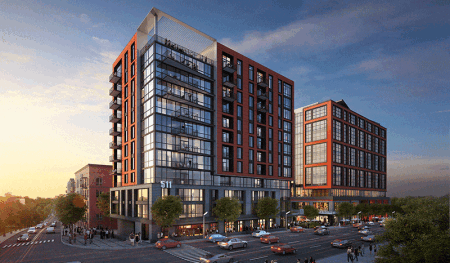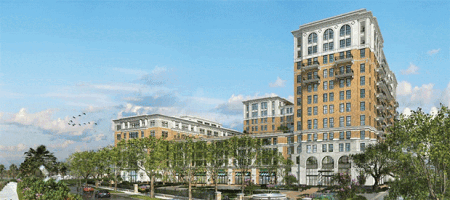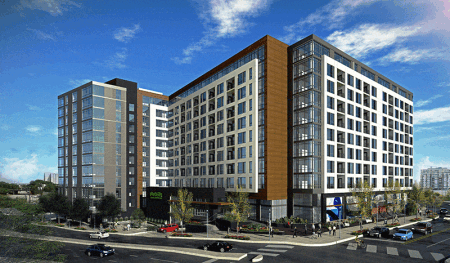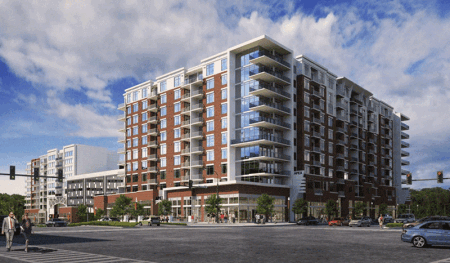It’s a long game that benefits from analysis, planning, and—it is hoped—a stroke of luck. That characterization of real estate development was illustrated by six developers who discussed their current projects at the 2019 ULI Carolinas Meeting in Raleigh in February. From projects that benefited from forward-looking church leaders, to decade-long timelines for redeveloping moribund sites, to downtowns that blossomed in the period between land acquisition and groundbreaking, the stories highlighted the patience, hard work, and serendipity needed for a project to come to fruition.
The panelists were Benjamin Cuevas, who is in charge of real estate development at the Charlotte-Mecklenburg Housing Partnership; Adam Golden, vice president of development at Northwood Ravin; Dan Doyle, senior vice president of development at the Beach Company; Warner Kuppin, director of residential development for Kane Realty Corporation; Robert Hughes, president of Hughes Development Corporation; and Chris Thomas, a partner with Childress Klein.
The Mezzanine at Freedom, Charlotte, North Carolina
It is not quite unheard of, but still radical: in 2017, Covenant Presbyterian Church in Charlotte announced it would be investing $2 million in a residential project by the Charlotte-Mecklenburg Housing Partnership. The project, which broke ground last December, is designed to include a substantial number of affordable units. Out of 185 apartments, two-thirds will be rented at below-market rates to people earning between 30 and 80 percent of the area median income; the rest will be set at market rates.
The location, two miles (3.2 km) from downtown, is a good one, said Ben Cuevas, who is in charge of real estate development at the Charlotte-Mecklenburg Housing Partnership, a nonprofit organization. “It’s a well-established corridor,” he noted. Nonetheless, the group would have struggled to simultaneously deeply lower its rents and earn investors a competitive return—even with low-income housing tax credits, which should cover about 30 percent of the construction cost.
Churches, however, are not necessarily looking for competitive returns on their investments. And Covenant Presbyterian’s decision is what made this project possible. “It’s a public/private/faith-based model,” said Cuevas. “We can only do it because of the partnership.”
The Van Alen and 555 Mangum, Durham, North Carolina
“I came across the site about six years ago. I had to buy the whole thing—it was the highest price for land in Durham then,” said Adam Golden of Northwood Ravin. “Now, prices are about 50 percent higher and I look like a genius,” he joked.
Golden was talking about a six-acre (2.4 ha) block in downtown Durham. It is actually the site of two Northwood Ravin projects: the Van Alen, a residential building holding 418 units that recently opened; and 555 Mangum, an 11-story office tower that is under construction that will also include 31,000 square feet (2,900 sq m) of retail.
Golden said the biggest challenge was connecting the project to nearby amenities, particularly a sparkling arts and entertainment area just a block away. “How do we tap the energy and magic of the American Tobacco Campus [ATC] and pull it east?” Golden asked rhetorically. “It’s not especially pedestrian friendly—there are four major arteries there, and three are one-way.”
In response, the company oriented the residential portion of the project closer to the ATC, and added an alley winding through the project that would bring some life into the development.
Despite its difficulties, Golden said his gut instincts about the centrally located site have borne out. “We knew it was a fantastic location” originally, he said. Six years later, the city has simply exploded with new residents and amenities.
The Jasper, Charleston, South Carolina
In 1950, the Beach Company in Charleston built the Sergeant Jasper apartment building, a 14-story, 232-unit building that was compatible with the era’s standards. Sixty-five years later, the company was ready for a change. Unfortunately, Charleston’s Board of Architectural Review (BAR) and much of the public was not.
“Development in Charleston is a contact sport,” said Dan Doyle, a senior vice president with the Beach Company. “It’s extremely difficult to develop there.”
He knows from firsthand experience. After a decade of planning a new, low-rise use for the property, the Beach Company submitted designs to the planning commission for rezoning. The aim was to almost double the site’s density, but opposition to the project became entrenched.
Eventually, the company scrapped those plans and tried again, with a new design that was the same height as the original building and almost the same number of units. Unlike the earlier plan, however, it included only luxury units, no workforce housing.
Once again, the company was denied. But this time, the Beach Company sued the BAR and won. “The judge recognized that challenges to the [historic preservation] ordinance were needed,” said Doyle. “Clearly, it’s still possible to do a large building in Charleston.” The groundbreaking was last August.
Peace Apartments, Raleigh, North Carolina
Downtown Raleigh was booming, but it still lacked something crucial: a grocery store. Finally in 2017, the Publix supermarket chain announced that the grocery store would be coming to Peace Street downtown. The 45,000-square-foot (4,200 sq m) store will be located on the ground floor of a 12-story, 417-unit apartment tower being developed by Kane Realty Corporation.
It has not been an easy process, said Kuppin. “Challenges include fitting into a tight, funky site. There’s a culvert, transmission lines, and a road realignment going on.” Plus, the parking numbers had to be right. Currently, Kane is planning for 515 parking spaces for residents, and another 200 for Publix shoppers.
But the location is a good one; formerly an underused strip of small, low-rise services, the neighborhood is in the midst of a wholesale shift. And Kane will be part of that. The company owns two other parcels nearby and has plans for office buildings, more residential uses, another 40,000 square feet (3,700 sq m) of retail space, and more.
BullStreet District, Columbia, South Carolina
Like several other cities, Columbia was ready to find a new life for the shuttered state asylum located near downtown. So in 2008, the state and city partnered to put it up for sale. “They marketed it for two years, and we were the only company to bid on it,” remembered Robert Hughes, president of the Greenville, South Carolina–based Hughes Development Corporation.
With 181 acres (73 ha) and a number of abandoned buildings, it was not a project for the faint of heart. But Hughes and his partners saw it as a 20-year project, and agreed to serve as master developer, helping set the vision and coordinate with other participating developers.
The idea is a walkable live/work/play campus. That vision came a little closer to fruition in 2016, when a ballpark for Columbia’s new minor league baseball team, the Fireflies, opened adjacent to the site. Next came a private office building that is currently a coworking space, residential units, and a Bone-In Barbeque—the site’s first restaurant, located in the old morgue.
Much more is yet to come: 200,000 square feet (18,600 sq m) of retail space, a hotel, a senior living complex, and a 20-acre (8.1 ha) park. And the entire area was designated an Opportunity Zone last year, bringing with it a new set of options.
“It’s a balancing act to harness the excitement of the community,” said Hughes. “They want to see things now, but it’s a 20-year project.”
Apex South Park, Charlotte, North Carolina
Another Charlotte developer benefited from a local church’s prudent decision. In this case, Sharon Methodist Church acknowledged that its membership was declining and issued a request for proposals for its property, ultimately selecting Childress Klein. “They challenged us to create a mixed-use scheme that included the church on a new site,” said Chris Thomas, a partner with the company.
Childress Klein has big plans for the 5.5-acre (2.2 ha) site, which is located across from SouthPark Mall. Along with 350 apartments—a few of which will be rented at subsidized rates—there will be 90,000 square feet (8,400 sq m) of retail, a 175-room hotel, and a six-story parking deck.
“We worked with the city and nearby neighborhoods to address growth-related issues,” said Thomas. And the company consulted closely with the church’s leaders; Childress Klein will build a new home for the congregation, which will be rechristened SouthPark Church.








![Western Plaza Improvements [1].jpg](https://cdn-ul.uli.org/dims4/default/15205ec/2147483647/strip/true/crop/1919x1078+0+0/resize/500x281!/quality/90/?url=https%3A%2F%2Fk2-prod-uli.s3.us-east-1.amazonaws.com%2Fbrightspot%2Fb4%2Ffa%2F5da7da1e442091ea01b5d8724354%2Fwestern-plaza-improvements-1.jpg)

